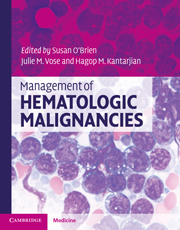Book contents
- Frontmatter
- Contents
- List of contributors
- 1 Molecular pathology of leukemia
- 2 Management of acute myeloid leukemia
- 3 Treatment of acute lymphoblastic leukemia (ALL) in adults
- 4 Chronic myeloid leukemia
- 5 Chronic lymphocytic leukemia/small lymphocytic lymphoma
- 6 Myelodysplastic syndromes (MDS)
- 7 Hairy cell leukemia
- 8 Acute promyelocytic leukemia: pathophysiology and clinical results update
- 9 Myeloproliferative neoplasms
- 10 Monoclonal gammopathy of undetermined significance, smoldering multiple myeloma, and multiple myeloma
- 11 Amyloidosis and other rare plasma cell dyscrasias
- 12 Waldenstrom's macroglobulinemia/lymphoplasmacytic lymphoma
- 13 WHO classification of lymphomas
- 14 Molecular pathology of lymphoma
- 15 International staging and response criteria for lymphomas
- 16 Treatment approach to diffuse large B-cell lymphomas
- 17 Mantle cell lymphoma
- 18 Follicular lymphomas
- 19 Hodgkin lymphoma: epidemiology, diagnosis, and treatment
- 20 Treatment approaches to MALT/marginal zone lymphoma
- 21 Peripheral T-cell lymphomas
- 22 Mycosis fungoides and Sézary syndrome
- 23 Central nervous system lymphoma
- 24 HIV-related lymphomas
- 25 Lymphoblastic lymphoma
- 26 Burkitt lymphoma
- Index
- References
22 - Mycosis fungoides and Sézary syndrome
Published online by Cambridge University Press: 10 January 2011
- Frontmatter
- Contents
- List of contributors
- 1 Molecular pathology of leukemia
- 2 Management of acute myeloid leukemia
- 3 Treatment of acute lymphoblastic leukemia (ALL) in adults
- 4 Chronic myeloid leukemia
- 5 Chronic lymphocytic leukemia/small lymphocytic lymphoma
- 6 Myelodysplastic syndromes (MDS)
- 7 Hairy cell leukemia
- 8 Acute promyelocytic leukemia: pathophysiology and clinical results update
- 9 Myeloproliferative neoplasms
- 10 Monoclonal gammopathy of undetermined significance, smoldering multiple myeloma, and multiple myeloma
- 11 Amyloidosis and other rare plasma cell dyscrasias
- 12 Waldenstrom's macroglobulinemia/lymphoplasmacytic lymphoma
- 13 WHO classification of lymphomas
- 14 Molecular pathology of lymphoma
- 15 International staging and response criteria for lymphomas
- 16 Treatment approach to diffuse large B-cell lymphomas
- 17 Mantle cell lymphoma
- 18 Follicular lymphomas
- 19 Hodgkin lymphoma: epidemiology, diagnosis, and treatment
- 20 Treatment approaches to MALT/marginal zone lymphoma
- 21 Peripheral T-cell lymphomas
- 22 Mycosis fungoides and Sézary syndrome
- 23 Central nervous system lymphoma
- 24 HIV-related lymphomas
- 25 Lymphoblastic lymphoma
- 26 Burkitt lymphoma
- Index
- References
Summary
Introduction
Cutaneous T-cell lymphomas (CTCL) represent a clinically and biologically heterogeneous group of non-Hodgkin lymphomas with clonal proliferation of malignant T lymphocytes homing into the skin according to the new revised World Health Organization and European Organization for Research and Treatment of Cancer (WHO–EORTC) consensus classification for cutaneous lymphomas. Mycosis fungoides (MF) and the aggressive and leukemic variant Sézary syndrome (SS), collectively referred to as CTCL, are the most common and best studied entities. CTCL include other entities such as lymphomatoid papulosis (LyP) and primary cutaneous anaplastic large T-cell lymphoma (ALCL), which belong to the CD30+ lymphoproliferative disorders and other rare diseases with distinct clinical features (Table 22.1).
MF disease is characterized by a chronic, slowly progressing course. The clinical manifestations typically include erythematous patches, evolving into plaques and/or tumors (Figure 22.1a–c). Patients usually present with a prolonged history of a skin rash in sun-protected areas such as lower abdomen, upper thighs, buttocks, and breasts in women. Patients with cutaneous patch/plaque disease have an excellent prognosis and a normal life expectancy compared with age-matched individuals. However, 20% of patients progress into more aggressive and advanced disease with either cutaneous or extracutaneous tumor manifestations. Three major variants have been recognized in the new WHO–EORTC classification including granulomatous slack skin, clinically characterized by the development of erythematous lax skin folds and histologically by a granulomatous T-cell infiltrate and loss of elastic fibers, folliculotropic MF, characterized by involvement of hair follicles with or without mucin deposition often leading to alopecia, and pagetoid reticulosis (Woringer–Kolopp disease), presenting as a slowly enlarging, solitary psoriasiform patch with intraepidermal involvement of atypical (pagetoid) T cells expressing a CD4−CD8+ phenotype.
- Type
- Chapter
- Information
- Management of Hematologic Malignancies , pp. 432 - 448Publisher: Cambridge University PressPrint publication year: 2010



